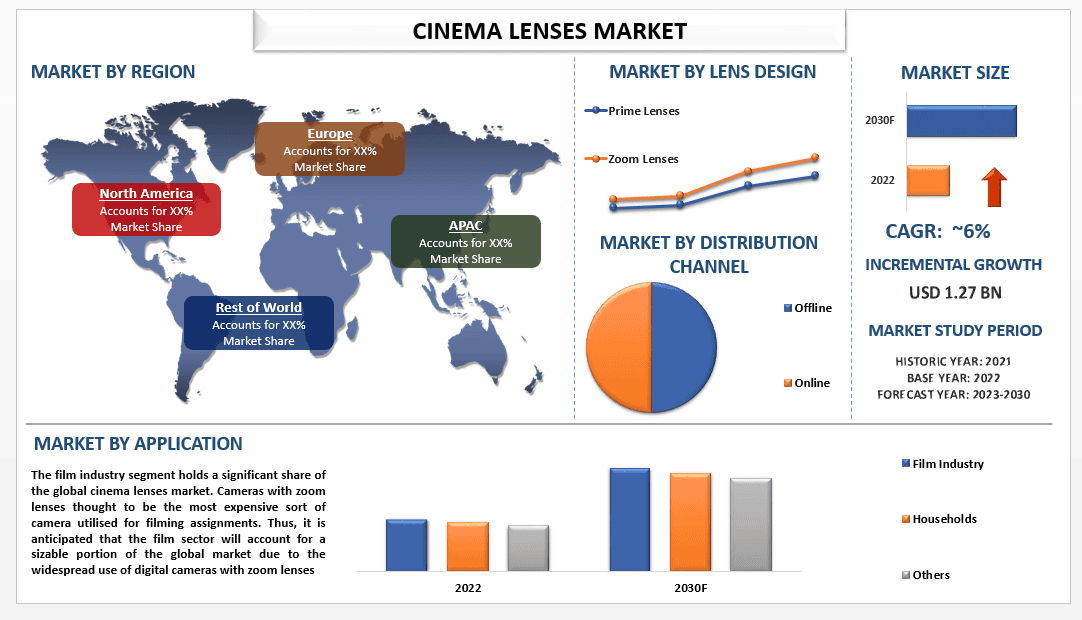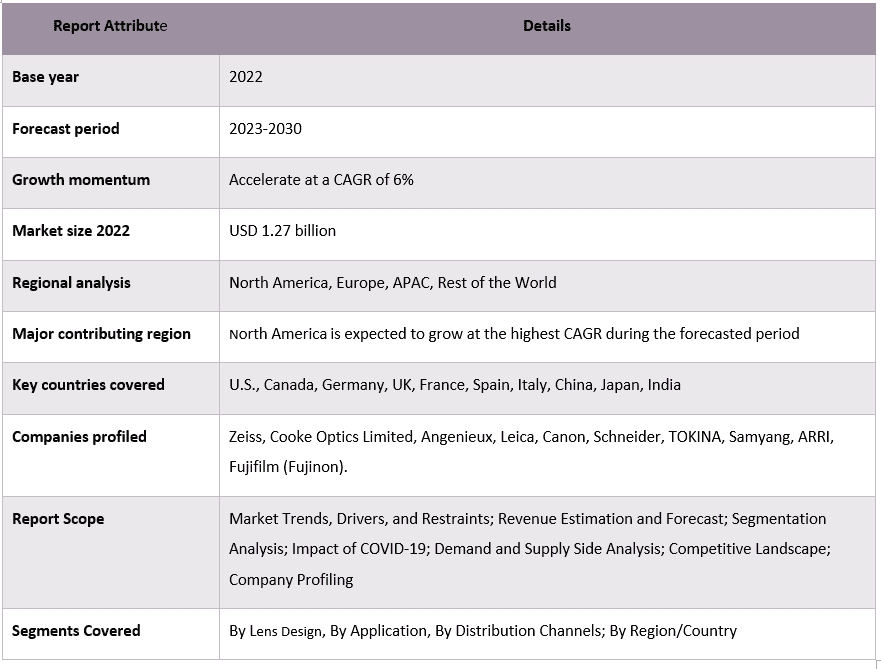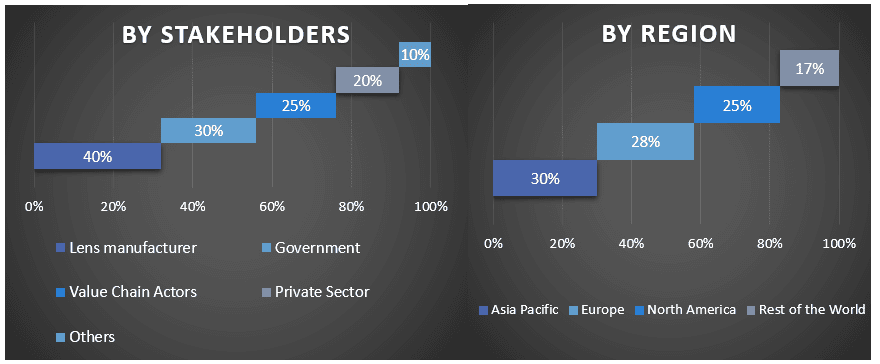- الرئيسية
- معلومات عنا
- صناعة
- الخدمات
- قراءة
- اتصل بنا
سوق عدسات السينما: التحليل الحالي والتوقعات (2023-2030)
التركيز على تصميم العدسات (العدسات الثابتة، العدسات المتغيرة)؛ التطبيق (صناعة الأفلام، المنازل، أخرى)؛ قناة التوزيع (غير متصل، عبر الإنترنت)؛ والمنطقة/البلد

من المتوقع أن ينمو سوق عدسات السينما بمعدل ثابت يبلغ حوالي 6٪ من معدل النمو السنوي المركب من عام 2023 إلى عام 2030. يشهد السوق العالمي لعدسات السينما ارتفاعًا بسبب زيادة الطلب على العدسات في قطاع الإعلام والترفيه. من المتوقع أن يشهد السوق العالمي للعدسات السينمائية المتطورة نموًا مدفوعًا بزيادة طلب المستهلكين على الأفلام من مختلف الأنواع. على مدار الفترة المتوقعة، من المتوقع أن يدعم تكامل تكنولوجيا الاستشعار والتصوير البصري في عدسات السينما نمو سوق عدسات السينما العالمي. من أجل زيادة إيراداتهم، يركز المنتجون في سوق عدسات الكاميرا العالمي على إنشاء عدسات سينمائية متطورة وبأسعار معقولة للتصوير الفوتوغرافي بالهاتف المحمول. على سبيل المثال، في عام 2020، في الهند، كشفت شركة Nikon، وهي شركة يابانية لتصنيع المنتجات البصرية، عن عدستين جديدتين من نوع Z كاملتي الإطار للسينما مع تقريب قياسي 24-70 مم وقدرات قياسية واسعة الزاوية.
بعض اللاعبين الرئيسيين العاملين في السوق هم Zeiss، وCooke Optics Limited، وAngenieux، وLeica، وCanon، وSchneider، وTOKINA، وSamyang، وARRI، وFujifilm (Fujinon).
الرؤى المقدمة في التقرير
"من بين تصميم العدسات، من المتوقع أن تشهد فئة العدسات الأولية أعلى معدل نمو سنوي مركب خلال الفترة المتوقعة"
استنادًا إلى تصميم العدسة، يتم تقسيم السوق إلى عدسات أولية وعدسات زوم. من المتوقع أن يشهد قطاع العدسات الأولية أعلى معدل نمو سنوي مركب خلال الفترة المتوقعة بسبب التقاط صور ومقاطع فيديو عالية الجودة مع تشويه أقل. حقيقة أن العدسات الأولية لها بعد بؤري ثابت يساعد على إنتاج صور بدرجة عالية من الجودة. ونتيجة لذلك، من المتوقع أنه على مدار الفترة قيد الدراسة، ستكون هناك زيادة في الطلب على العدسات الأولية السينمائية على مستوى العالم. على سبيل المثال، في عام 2020، قدمت شركة Nikon Corporation عدستين سينمائيتين جديدتين تضمان حجم تقريب قياسي وميزات زاوية واسعة أساسية وميزات أساسية قياسية في الهند.
"من بين التطبيقات، من المتوقع أن يكون قطاع صناعة الأفلام هو الأسرع نموًا في سوق عدسات السينما خلال الفترة المتوقعة"
استنادًا إلى التطبيق، يتم تقسيم السوق إلى صناعة الأفلام والأسر وغيرها. من المتوقع أن يكون قطاع صناعة الأفلام هو الأسرع نموًا في سوق عدسات السينما خلال الفترة المتوقعة. في صناعة صناعة الأفلام الحديثة، عادةً ما يتم تصوير لقطات الفيديو عالية الدقة بكاميرات فيديو ذات جودة مماثلة لـ 4k. على سبيل المثال، في عام 2022، تم طرح عدسة فيلم جديدة من Zeiss في السوق، وهي Supreme Prime 15 mm T1.8. هذا الجهاز الممتاز محمول وقابل للتكيف. يهدف إطلاق المنتج إلى تلبية الطلب المتزايد من صناعة الأفلام. في الإنتاج العرضي المتطور، استفاد المصورون السينمائيون في جميع أنحاء العالم من العدسة.
تغطية تقرير سوق عدسات السينما

"من بين قناة التوزيع، من المتوقع أن يكون القطاع عبر الإنترنت هو الأسرع نموًا في سوق عدسات السينما خلال الفترة المتوقعة"
استنادًا إلى قناة التوزيع، يتم تقسيم السوق إلى قطاعين غير متصلين بالإنترنت وعبر الإنترنت. من المتوقع أن يكون القطاع عبر الإنترنت هو الأسرع نموًا في سوق عدسات السينما خلال الفترة المتوقعة. يتيح السوق عبر الإنترنت تصفح مجموعة أكبر بكثير من عدسات السينما مما هو متاح في المتاجر الفعلية. يمكن للعملاء أيضًا قراءة تقييمات المنتج وتقييمات من مستخدمين آخرين لعدسات سينمائية معينة. من الممكن مقارنة عدة أنواع من عدسات السينما من مختلف العلامات التجارية من خلال القنوات عبر الإنترنت.
"من المتوقع أن تستحوذ منطقة آسيا والمحيط الهادئ على حصة كبيرة في سوق عدسات السينما"
من المتوقع أن تستحوذ منطقة آسيا والمحيط الهادئ على حصة كبيرة من سوق عدسات السينما العالمي بحلول نهاية الفترة المتوقعة. يتم دعم توسع السوق في المنطقة إلى حد كبير من خلال دول مثل الصين واليابان التي تزيد من معدل إنتاج الكاميرات الرقمية. على سبيل المثال، تظهر بيانات جمعية منتجات الكاميرات والتصوير أن حجم الكاميرات المزودة بعدسات مدمجة أنتجت بين يناير 2020 ويونيو 2020 نما من 162972 إلى 1455999 في المنطقة، مما يدل على قوة سوق عدسات السينما في المنطقة.
أسباب شراء هذا التقرير:
- تتضمن الدراسة تحليل تقدير حجم السوق والتنبؤ به تم التحقق من صحته بواسطة خبراء الصناعة الرئيسيين الموثوق بهم.
- يقدم التقرير مراجعة سريعة للأداء العام للصناعة في لمحة.
- يغطي التقرير تحليلاً متعمقًا لأقران الصناعة البارزين مع التركيز الأساسي على البيانات المالية الرئيسية للأعمال، ومجموعة المنتجات، واستراتيجيات التوسع، والتطورات الأخيرة.
- دراسة تفصيلية للمحركات والقيود والاتجاهات الرئيسية والفرص السائدة في الصناعة.
- تغطي الدراسة السوق بشكل شامل عبر قطاعات مختلفة.
- تحليل متعمق على المستوى الإقليمي للصناعة.
خيارات التخصيص:
يمكن تخصيص سوق عدسات السينما العالمي بشكل أكبر وفقًا للمتطلبات أو أي شريحة سوقية أخرى. إلى جانب ذلك، تتفهم UMI أن لديك احتياجات عمل خاصة بك، لذا لا تتردد في التواصل معنا للحصول على تقرير يناسب متطلباتك تمامًا.
جدول المحتويات
منهجية البحث لتحليل سوق عدسات السينما (2023-2030)
كان تحليل السوق التاريخي وتقدير السوق الحالي والتنبؤ بسوق عدسات السينما العالمي المستقبلي هي الخطوات الرئيسية الثلاث التي تم اتخاذها لإنشاء وتحليل اعتماد سوق عدسات السينما في المناطق الرئيسية على مستوى العالم. تم إجراء بحث ثانوي شامل لجمع أرقام السوق التاريخية وتقدير حجم السوق الحالي. ثانيًا ، للتحقق من صحة هذه الرؤى ، تم أخذ العديد من النتائج والافتراضات في الاعتبار. علاوة على ذلك ، تم أيضًا إجراء مقابلات أولية شاملة مع خبراء الصناعة عبر سلسلة القيمة لسوق عدسات السينما العالمي. بعد افتراض أرقام السوق والتحقق من صحتها من خلال المقابلات الأولية ، استخدمنا نهجًا من أعلى إلى أسفل / من أسفل إلى أعلى للتنبؤ بحجم السوق الكامل. بعد ذلك ، تم اعتماد طرق تقسيم السوق وتثليث البيانات لتقدير وتحليل حجم سوق القطاعات والقطاعات الفرعية للصناعة المعنية. يتم شرح المنهجية التفصيلية أدناه:
تحليل حجم السوق التاريخي
الخطوة 1: دراسة متعمقة للمصادر الثانوية:
تم إجراء دراسة ثانوية تفصيلية للحصول على حجم السوق التاريخي لسوق عدسات السينما من خلال مصادر الشركة الداخلية مثل التقارير السنوية والبيانات المالية وعروض الأداء والنشرات الصحفية وما إلى ذلك ، ومصادر خارجية بما في ذلك المجلات والأخبار والمقالات والمنشورات الحكومية ومنشورات المنافسين وتقارير القطاعات وقاعدة بيانات الطرف الثالث والمنشورات الموثوقة الأخرى.
الخطوة 2: تجزئة السوق:
بعد الحصول على حجم السوق التاريخي لسوق عدسات السينما ، أجرينا تحليلًا ثانويًا مفصلاً لجمع رؤى السوق التاريخية ومشاركتها للقطاعات والقطاعات الفرعية المختلفة للمناطق الرئيسية. يتم تضمين القطاعات الرئيسية في التقرير كتصميم العدسة والتطبيق وقناة التوزيع. تم إجراء المزيد من التحليلات على مستوى الدولة لتقييم الاعتماد الكلي لنماذج الاختبار في تلك المنطقة.
الخطوة 3: تحليل العوامل:
بعد الحصول على حجم السوق التاريخي للقطاعات والقطاعات الفرعية المختلفة ، أجرينا تحليلًا تفصيليًا للعوامل لتقدير حجم السوق الحالي لسوق عدسات السينما. علاوة على ذلك ، أجرينا تحليلًا للعوامل باستخدام متغيرات تابعة ومستقلة مثل تصميم العدسة وتطبيق وقناة توزيع سوق عدسات السينما. تم إجراء تحليل شامل لسيناريوهات جانب الطلب والعرض مع الأخذ في الاعتبار أهم الشراكات وعمليات الاندماج والاستحواذ والتوسع التجاري وإطلاق المنتجات في قطاع سوق عدسات السينما في جميع أنحاء العالم.
تقدير وتوقع حجم السوق الحالي
تقدير حجم السوق الحالي: بناءً على رؤى قابلة للتنفيذ من الخطوات الثلاث المذكورة أعلاه ، توصلنا إلى حجم السوق الحالي واللاعبين الرئيسيين في سوق عدسات السينما العالمي والحصص السوقية للقطاعات. تم تحديد جميع النسب المئوية المطلوبة وتقسيمها ، وتم تحديد تقسيمات السوق باستخدام النهج الثانوي المذكور أعلاه وتم التحقق منها من خلال المقابلات الأولية.
التقدير والتنبؤ: لتقدير السوق والتنبؤ به ، تم تخصيص أوزان لعوامل مختلفة بما في ذلك المحركات والاتجاهات والقيود والفرص المتاحة لأصحاب المصلحة. بعد تحليل هذه العوامل ، تم تطبيق تقنيات التنبؤ ذات الصلة ، أي النهج من أعلى إلى أسفل / من أسفل إلى أعلى ، للتوصل إلى توقعات السوق لعام 2028 للقطاعات والقطاعات الفرعية المختلفة عبر الأسواق الرئيسية على مستوى العالم. تتضمن منهجية البحث المعتمدة لتقدير حجم السوق ما يلي:
- حجم سوق الصناعة ، من حيث الإيرادات (بالدولار الأمريكي) ومعدل اعتماد سوق عدسات السينما عبر الأسواق الرئيسية محليًا
- جميع الحصص المئوية والانقسامات والتقسيمات الفرعية لقطاعات السوق والقطاعات الفرعية
- اللاعبون الرئيسيون في سوق عدسات السينما العالمي من حيث المنتجات المعروضة. أيضًا ، استراتيجيات النمو التي يتبناها هؤلاء اللاعبون للتنافس في السوق سريع النمو
التحقق من صحة حجم السوق وحصته
البحث الأولي: تم إجراء مقابلات متعمقة مع قادة الرأي الرئيسيين (KOLs) بمن فيهم كبار المسؤولين التنفيذيين (CXO/VPs ورئيس المبيعات ورئيس التسويق ورئيس العمليات والرئيس الإقليمي والرئيس القطري وما إلى ذلك) في المناطق الرئيسية. ثم تم تلخيص نتائج البحث الأولي وإجراء تحليل إحصائي لإثبات الفرضية المذكورة. تم دمج المدخلات من البحث الأولي مع النتائج الثانوية ، وبالتالي تحويل المعلومات إلى رؤى قابلة للتنفيذ.
تقسيم المشاركين الأساسيين في مناطق مختلفة

هندسة السوق
تم استخدام تقنية تثليث البيانات لإكمال تقدير السوق الإجمالي والتوصل إلى أرقام إحصائية دقيقة لكل قطاع وقطاع فرعي من سوق عدسات السينما العالمي. تم تقسيم البيانات إلى عدة قطاعات وقطاعات فرعية بعد دراسة المعلمات والاتجاهات المختلفة في مجالات تصميم العدسة والتطبيق وقناة التوزيع في سوق عدسات السينما العالمي.
الهدف الرئيسي من دراسة سوق عدسات السينما العالمي
تم تحديد اتجاهات السوق الحالية والمستقبلية لسوق عدسات السينما العالمي في الدراسة. يمكن للمستثمرين الحصول على رؤى استراتيجية لارتكاز تقديرهم للاستثمارات على التحليل النوعي والكمي الذي تم إجراؤه في الدراسة. حددت اتجاهات السوق الحالية والمستقبلية الجاذبية الإجمالية للسوق على المستوى الإقليمي ، مما يوفر منصة للمشارك الصناعي لاستغلال السوق غير المستغل للاستفادة من ميزة المحرك الأول. تشمل الأهداف الكمية الأخرى للدراسات ما يلي:
- تحليل حجم السوق الحالي والمتوقع لسوق عدسات السينما من حيث القيمة (بالدولار الأمريكي). أيضًا ، تحليل حجم السوق الحالي والمتوقع للقطاعات والقطاعات الفرعية المختلفة
- تشمل القطاعات في الدراسة مجالات تصميم العدسة والتطبيق وقناة التوزيع.
- تحديد وتحليل الإطار التنظيمي لعدسات السينما
- تحليل سلسلة القيمة المتضمنة مع وجود وسطاء مختلفين ، إلى جانب تحليل سلوكيات العملاء والمنافسين في الصناعة.
- تحليل حجم السوق الحالي والمتوقع لسوق عدسات السينما للمنطقة الرئيسية.
- تشمل الدول الرئيسية في المناطق التي تمت دراستها في التقرير منطقة آسيا والمحيط الهادئ وأوروبا وأمريكا الشمالية وبقية العالم.
- الملفات التعريفية للشركات في سوق عدسات السينما واستراتيجيات النمو التي يتبناها اللاعبون في السوق للاستمرار في السوق سريع النمو
- تحليل متعمق على المستوى الإقليمي للصناعة
الأسئلة الشائعة الأسئلة الشائعة
س1: ما هو حجم السوق الحالي وإمكانات النمو لسوق عدسات السينما العالمي؟
س2: ما هي المحركات الدافعة لنمو سوق عدسات السينما العالمي؟
س٣: أي شريحة لديها الحصة الأكبر من سوق عدسات السينما العالمي حسب تصميم العدسة؟
س4: ما هي الفرص الناشئة في سوق عدسات السينما العالمي؟
س5: أي منطقة ستسيطر على سوق عدسات السينما العالمي؟
س6: من هم اللاعبون الرئيسيون العاملون في سوق عدسات السينما العالمي؟
ذات صلة التقارير
العملاء الذين اشتروا هذا المنتج اشتروا أيضًا










